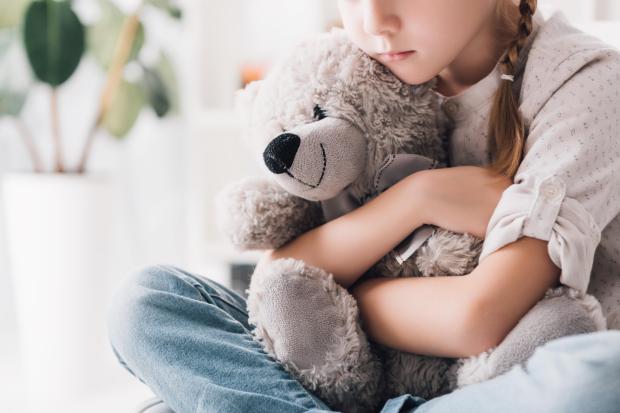Teens at risk of self-harm can be identified a DECADE earlier – how to spot signs in your 5-year-old

TEENS at risk of self-harm can be identified up to a decade earlier, a study has found.
Some “significant” signs were clear from the age of five, but others were not until adolescence.
Self-harm is when someone hurts themselves, such as by deliberately cutting themselves, as a way of dealing with very difficult feelings or painful memories, for example.
It is considered relatively common - between 14 and 20 per cent of adolescents in England self-harms, according to the study researchers at the University of Cambridge.
But somehow there has been little progress in the accurate prediction of self-harm, until sometimes it is too late.
The Cambridge team set out to find predictors of self harm so that in the future it may be easier to prevent.
In their study, they included teens who reported self-harm at age 14 from a nationally representative UK birth cohort of approximately 11,000 people.
Using data from years of research, the team traced back in time to see what the teenagers’ behaviour was like over their life.
They were able to spot things that occurred before someone started reporting self-harm behaviour, such as low self-esteem.
Signs of self-harm risk
Two clear groups emerged in those who self harmed, according to the results published in the Journal of the American Academy of Child and Adolescent Psychiatry.
The first group were more likely to:
At age 5:
- Have poor emotional control
- Have early weekday bedtimes
At age 7:
- Have a lower appetite
- Be bullied
- Have parents/caregivers with mental health issues or “emotional challenges” of their own
At age 11:
- Frequently argue with friends
At age 14:
- Have low self-esteem
- Wake during sleep and trouble falling asleep
- Have more arguments with caregivers
- Be unhappy at school
- Have a long history of poor mental health, such as depression
The second group were more likely to:
At age 5:
- Enjoy school
- Have a parent/caregiver who drinks a lot
At age 7:
- Have less difficulty with maths
At age 11:
- Care about others feelings
- Spend lots of time gaming (computer or similar)
At age 14:
- Take part in risk-taking behaviour
- Feel insecure with friends and family and have a low support system
- Have low self esteem
- Have trouble falling asleep
- Have parents/caregivers who say they are extraverted
“Notably, both groups could be predicted almost a decade before the reported self-harm,” the researchers said in their paper.
But it was more difficult to identify those who were part of the second group in childhood.
Don't wait
Stepheni Uh, a Gates Cambridge Scholar and first author of the study, said: “We found two distinct subgroups of young people who self-harm.
“The first was much as expected – young people who experience symptoms of depression and low self-esteem, face problems with their families and friends, and are bullied.
“The second, much larger group was much more surprising as they don’t show the usual traits that are associated with those who self-harm.”
The 14 signs your child is self harming
Experts say these are some of the warning signs that might suggest your child is self-harming:
- Withdrawal or isolation from everyday life
- Signs of depression such as low mood, tearfulness or a lack of motivation or interest in anything
- Changes in mood
- Changes in eating/sleeping habits
- Changes in activity and mood, e.g. more aggressive than usual
- Talking about self-harming or suicide
- Abusing drugs or alcohol
- Expressing feelings of failure, uselessness or loss of hope
- Risk taking behaviour (substance misuse, unprotected sexual acts)
- Signs of low self-esteem such as blaming themselves for any problems or saying they are not good enough
- Unexplained cuts, bruises or marks
- Covering up all the time, when in hot weather
- Being quieter than usual
- Lacking energy
He added: “Self-harm is a significant problem among adolescents, so it’s vital that we understand the nuanced nature of self-harm, especially in terms of the different profiles of young people who self-harm and their potentially different risk factors.”
Dr Duncan Astle said: “The current approach to supporting mental health in young people is to wait until problems escalate.
“Instead, we need a much better evidence base so we can identify who is at most risk of mental health difficulties in the future, and why.
“This offers us the opportunity to be proactive, and minimise difficulties before they start.”
Dr Astle said self harm could be prevented by “boosting younger children’s self-esteem, making sure that schools implement anti-bullying measures, and providing advice on sleep training”.
You’re not alone
Self harm can come in a variety of forms, such as alcohol and drug abuse.
Someone may not literally hurt or cut themselves, but do things such as get into fights, have an eating disorder or get into situations where they could get hurt, all in order to bring temporary relief to pain.
Most read in Fabulous
Self harm is also linked to an increased risk of suicide.
Read More on The Sun
Suicide is the biggest killer of people under the age of 35, more deadly than cancer and car crashes.
The Sun's You're Not Alone campaign aims to help prevent deaths from suicide to remind those who are facing a difficult time that there is hope.
WHERE TO GET HELP
If you, or anyone you know, needs help dealing with mental health problems, the following organisations provide support:
- CALM, , 0800 585 858
- Heads Together,
- Mind, , 0300 123 3393
- Papyrus,, 0800 068 41 41
- Samaritans, , 116 123








